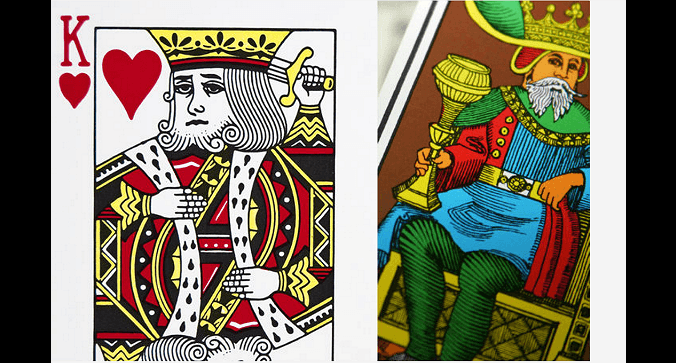Many people know that the playing cards of today are derived from the same roots as the Tarot, but few notice that the King of Hearts has been committing suicide since around 1680.
Much is known about the history of playing cards, but surprisingly, much is still a mystery. Over the centuries, countless sets of cards have been developed by different cultures using different artistic styles, but card playing was banned in many places for much of history, and the fragile paper cards were frequently damaged, destroyed, or lost. Tracing the evolution of the modern standard deck of cards is difficult given the limited number of complete historical decks available.
In China around 1000 A.D., there were suited strips of paper, but they were used as poker chips for a dice game. The first verifiable evidence of suited card games dates back to 14th century Europe. Both the Tarot and the modern playing card deck evolved from the same set of cards, which are now called the Minor Arcana.
There are two sets of cards in the Tarot deck. The Minor Arcana are divided into 4 suits of 14 cards each (56 total), which are similar to today’s standard deck of 52 playing cards. The Italians added 22 special cards for a game called Tarocco, which are called the Major Arcana. These are the visually striking, heavily symbolic cards for which Tarot is famous, such as The Magician, The Tower, and The Empress. The name Tarot derives from Tarocco, and the Tarot decks used by psychics today are virtually unchanged from the Tarocco deck. However, evidence that Tarocco cards were used to tell fortunes does not appear until 1780.
There are many ways to read fortunes with cards, varying by card design, fortunetelling tradition, and the individual reader. Typically, the Major Arcana direct the main subject of the reading, and the Minor Arcana give more detail. Each card has a meaning, and by connecting the meanings based on the order in which the cards are drawn, the past, present, or future can be told. For example, some readers interpret the Major Arcana card The Wheel of Fortune to mean “change” and the Minor Arcana 7 of Wands to mean “communication.” The two together could mean “change because of gossip” or “a change in the gossip.”
The 56 cards of the Minor Arcana evolved into the modern 52-card standard playing deck with the deletion of the four “Page” cards, which were between the 10 and the Knight (now the Jack). Wands became clubs, coins or pentacles became diamonds, swords became spades, and cups became hearts.
Our search for the Suicide King of Hearts therefore originates in the history of the King of Cups. Most Tarot practitioners consider the King of Cups to symbolize a tranquil intellect in full touch with his emotions. Clearly this does not relate to the symbolism of suicide. Somewhere in history, a change took place where the King of Cups transformed to nearly the opposite of his spiritual meaning.
Our first line of questioning is to ask whether the suicide of the King of Hearts originated in some historical event. Many decks contained depictions of the royalty of the times, with different countries and artists portraying the kings they were familiar with. Many historical kings have had the honor of being portrayed on playing cards. Over time, one depiction has survived to become the current standard version, but reports vary about which king it was.
It is widely believed that Charles the Great (AKA Charlemagne) is the King of Hearts, but since he lived to be 71 (very old in 814 A.D.), the suicide depiction does not ring true. Other reports say the King of Hearts is Alexander the Great, who died at age 32 in 323 B.C. He was heartbroken because of the recent death of his possible lover Hephaestion, but evidence indicates Alexander was poisoned and it was not self-inflicted. Also in the running for the King of Hearts is Charles VII of France, who went mad from a form of mouth cancer and died in 1461 due to his inability to eat or drink. Tales circulate about how he violently cut his own throat open to eat and that the “Suicide King” depicts this—but this is a modern legend with no basis in history.
There seem to have been no historical suicides of real kings that could have caused the change in the image.





